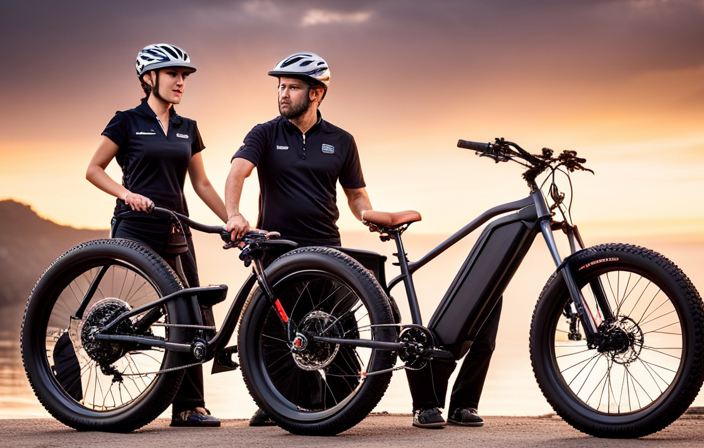As the saying goes, ‘knowledge is power,’ and when it comes to electric bikes, knowing how to calculate battery capacity is crucial for maximizing performance and efficiency.
In this article, I will guide you through the process of determining the right battery capacity for your electric bike. By understanding the basics, assessing your riding needs, and crunching some numbers, you’ll be able to make an informed decision and ensure your battery meets your requirements.
So let’s dive into the technical world of battery capacity calculation for electric bikes.
Key Takeaways
- Consider the distance, detours, and terrain when calculating the battery capacity for an electric bike.
- Evaluate the charging time and access to charging stations to ensure sufficient battery range.
- Look for regenerative braking capabilities and swappable batteries for extended range and convenience.
- Choose a battery with the right chemistry and energy density for specific needs, considering the pros and cons of different battery chemistries.
Understand the Basics of Electric Bike Batteries
To understand the basics of electric bike batteries, it’s important to know how to calculate their capacity. Electric bike battery life is determined by several key factors.
The first is the battery’s voltage, which is typically measured in volts (V). A higher voltage generally means a longer battery life.
The second factor is the battery’s ampere-hours (Ah), which represents the amount of charge the battery can deliver over a certain period of time. A higher Ah rating means a longer battery life as well.
Additionally, the battery’s power output, measured in watts (W), also affects its performance. Other factors that impact battery performance include the rider’s weight, terrain, and speed.
By understanding these factors and how they interact, you can determine the right battery capacity for your electric bike.
Transitioning into the subsequent section, determining your riding needs and habits is crucial in making an informed decision.
Determine Your Riding Needs and Habits
Consider your riding needs and habits when determining the right battery size for your e-bike. To make an informed decision, take into account your riding preferences and the battery lifespan.
Here are some key factors to consider:
- Distance: Think about how far you typically ride in a single trip.
- Terrain: Consider the type of terrain you ride on, as hilly terrains require more power.
- Speed: Determine the average speed you ride at, as higher speeds tend to drain the battery faster.
- Rider weight: Take into account your weight, as heavier riders may require more power.
- Riding style: Assess whether you tend to ride aggressively or conservatively, as this affects battery consumption.
Understanding these factors will help you select the appropriate battery size for your electric bike.
Moving forward, let’s delve into calculating your power consumption and making an accurate estimation.
Calculate Your Power Consumption
To calculate the power consumption of my electric bike components, I need to determine the energy requirements of each individual part. This includes considering the motor, lights, display, and any other accessories that may be drawing power.
Once I have these values, I can estimate my power consumption per kilometer or mile by dividing the total energy usage by the distance traveled.
By understanding my power consumption, I can better plan for battery capacity and usage on my electric bike.
Determine the Power Consumption of Your Electric Bike Components
The power consumption of your electric bike components can easily be determined. To calculate the energy efficiency and optimize battery performance, follow these steps:
-
Identify the power rating of each component: Start by determining the power rating of your electric motor, controller, and any other electrical devices on your bike.
-
Multiply the power rating by the operating time: Once you have the power rating for each component, multiply it by the time the component is in use. This will give you the energy consumed by each component.
-
Sum up the energy consumption: Add up the energy consumption of all the components to get the total power consumption of your electric bike.
By calculating the power consumption of your electric bike components, you can estimate your power consumption per kilometer or mile. This information will help you evaluate and optimize the performance of your battery.
Estimate Your Power Consumption per Kilometer or Mile
To estimate your power consumption per kilometer or mile, you can simply multiply the energy consumed by each component of your electric bike by the distance traveled. This will give you an idea of how much energy your bike consumes on average for each kilometer or mile. By estimating your energy usage, you can better understand how to optimize the power efficiency of your electric bike.
To further help you in this process, here is a table that showcases the energy consumption of common electric bike components:
| Component | Energy Consumption (Wh) |
|---|---|
| Motor | 500 |
| Lights | 20 |
| Controller | 50 |
By multiplying these values by the distance traveled, you can determine the energy consumed by each component. This information will be valuable when choosing the right battery type for your electric bike.
Choose the Right Battery Type
Make sure you choose the right battery type for your electric bike. When considering the battery lifespan, it’s important to select a battery that can withstand the demands of your biking needs. Factors such as the number of charge cycles and the overall durability of the battery should be taken into account.
Additionally, battery weight is a crucial aspect to consider, as it can impact the overall performance and handling of your electric bike. Opting for a lightweight battery can enhance your riding experience and make it easier to maneuver.
Now, let’s move on to the next section where we will discuss how to calculate the battery capacity needed for your electric bike.
Calculate the Battery Capacity Needed
To calculate the battery capacity needed for an electric bike, I use the formula: Capacity (Ah) = Power Consumption (Wh) / Voltage (V).
This formula allows me to determine the appropriate capacity based on the power consumption and voltage requirements of the bike.
However, I also adjust for efficiency and safety margins to ensure optimal performance and lifespan of the battery.
Use the Formula: Capacity (Ah) = Power Consumption (Wh) / Voltage (V)
The formula for calculating battery capacity for an electric bike is:
Capacity (Ah) = Power Consumption (Wh) / Voltage (V).
To determine the voltage requirements, you need to consider the power consumption of the electric bike. This can be calculated by multiplying the average power consumption (W) by the desired runtime (hours).
Once you have the power consumption in watt-hours (Wh), you can divide it by the voltage (V) to get the battery capacity in ampere-hours (Ah).
It is important to calculate power efficiency, as it can affect the overall battery capacity needed. By considering the efficiency of the electric bike’s components, such as the motor and controller, you can adjust the power consumption and ensure that the battery capacity is sufficient.
It is also crucial to include safety margins to account for unexpected power demands or variations in the actual power consumption. This will help ensure that the battery can handle any fluctuations in power requirements.
Therefore, adjusting for efficiency and safety margins is essential to accurately calculate the battery capacity for an electric bike.
Adjust for Efficiency and Safety Margins
Adjusting for efficiency and safety margins is crucial to accurately determine the required battery capacity for an e-bike. When calculating the battery capacity, it is important to consider safety precautions and efficiency optimization.
Safety margins should be taken into account to ensure that the battery can handle peak power demands and prevent any potential hazards. Additionally, efficiency optimization plays a vital role in maximizing the battery’s performance and extending its lifespan. This involves minimizing energy losses and choosing components that are known for their high efficiency.
By adjusting for these factors, we can ensure that the calculated battery capacity not only meets the power requirements of the electric bike but also provides a safe and efficient operation.
Taking these considerations into account, let’s now consider battery range and charging options in order to further optimize the e-bike’s performance.
Consider Battery Range and Charging Options
Calculate battery capacity for your electric bike by considering the battery range and your charging options.
To ensure a sufficient range, take into account the distance you plan to travel and any potential detours. Additionally, consider your charging options, such as whether you have access to a charging station or if you will rely on home charging.
-
Sub-list 1:
-
Charging time: Look for a battery that charges quickly to minimize downtime.
-
Battery lifespan: Consider the expected lifespan of the battery to ensure it will last for your needs.
-
Sub-list 2:
-
Energy recovery systems: Opt for a battery that has regenerative braking capabilities to extend its range.
-
Swappable battery: If available, consider a bike with a removable battery to easily swap it out for a fully charged one.
By carefully considering these factors, you can select a battery with the appropriate capacity for your electric bike.
Next, let’s explore the importance of looking for battery features and specifications.
Look for Battery Features and Specifications
When selecting a battery for your e-bike, it’s important to consider the features and specifications. Two crucial factors to evaluate are the battery lifespan and weight. The battery lifespan refers to the number of charge cycles the battery can endure before its capacity significantly diminishes. It is essential to choose a battery with a long lifespan to maximize the overall longevity of your e-bike. Additionally, battery weight plays a significant role in the performance and handling of your electric bike. A lighter battery will allow for improved maneuverability and a more enjoyable riding experience. To make an informed decision, refer to the table below, comparing the battery lifespan and weight of different options:
| Battery Model | Lifespan (charge cycles) | Weight (kg) |
|---|---|---|
| Model A | 1000 | 2.5 |
| Model B | 1500 | 3.2 |
| Model C | 2000 | 4.0 |
| Model D | 2500 | 4.8 |
Considering these factors will help you select the ideal battery for your e-bike. For further guidance, consult with experts or refer to the manufacturer’s recommendations.
Consult with Experts or Manufacturer Recommendations
To get the best advice on choosing the right battery for your e-bike, consult with experts or check the manufacturer’s recommendations. They can provide valuable insights on battery capacity and guide you through the calculation techniques.
Here are some important factors to consider when determining the battery capacity for your electric bike:
- Riding Distance: Determine how far you typically ride and choose a battery with enough capacity to cover that distance.
- Terrain: Consider the type of terrain you usually ride on, as uphill climbs and rough surfaces may require a higher battery capacity.
- Weight: Take into account your body weight and any additional weight you may carry, such as cargo or accessories, as this affects the battery’s performance.
- Power Output: Consider the power output you require for your e-bike, as higher power output may require a larger battery capacity.
- Battery Chemistry: Different battery chemistries have different energy densities, so it’s important to choose the right chemistry for your needs.
Considering these factors will help you select the appropriate battery capacity for your electric bike. With the right battery, you can enjoy optimal performance and efficiency.
Now, let’s move on to the next section and explore how to consider future upgrades or expansion.
Consider Future Upgrades or Expansion
Considering future upgrades or expansion is essential when selecting the right battery for your e-bike. As technology advances, new features and capabilities may become available, and you’ll want a battery that can support these upgrades. Additionally, if you plan on increasing the range or power of your e-bike in the future, it’s crucial to choose a battery with enough capacity to accommodate these changes.
By carefully considering future upgrades and expansion planning, you can avoid the hassle and expense of having to replace your battery sooner than necessary. Furthermore, selecting a battery that allows for easy integration of additional modules or cells can provide flexibility for future modifications. This forward-thinking approach ensures that your e-bike will be ready for any enhancements you may want to make.
Moving forward, it’s important to also consider the budget for battery cost and maintenance, ensuring a well-rounded approach to your overall e-bike requirements.
Budget for Battery Cost and Maintenance
It’s crucial to factor in the cost and maintenance of the battery when budgeting for your e-bike. The battery lifespan is a significant consideration that affects the overall cost.
Several factors influence the battery cost, including the type of battery, its capacity, and the brand. Lithium-ion batteries, for example, are more expensive initially but have a longer lifespan compared to lead-acid batteries. Additionally, the capacity of the battery, measured in ampere-hours (Ah), impacts its cost. Higher capacity batteries generally have a higher price tag.
Furthermore, the brand reputation and quality also play a role in determining the battery cost. Considering these factors and researching different options can help you estimate and budget for the battery cost and maintenance of your electric bike effectively.
Frequently Asked Questions
What are the different types of electric bike batteries available in the market?
There are several types of electric bike batteries available in the market, each with its own advantages and disadvantages. Factors to consider include battery capacity, weight, lifespan, and cost.
Can I use a higher capacity battery than recommended for my electric bike?
Using a higher capacity battery in an electric bike has advantages, such as longer range and increased power. However, it may lead to potential risks like increased weight and strain on the motor.
How long does it take to fully charge an electric bike battery?
The charging time of an electric bike battery depends on various factors such as the battery capacity, charger output, and the current charge level. It typically takes several hours to fully charge an electric bike battery.
Are there any safety precautions I need to take while using and charging the battery?
When using and charging electric bike batteries, it is crucial to take safety precautions to avoid potential dangers. These include using the correct charger, avoiding overcharging, storing batteries in a cool and dry place, and inspecting for any damage before each use.
Can I upgrade the battery capacity of my electric bike in the future?
Yes, it is possible to upgrade the battery capacity of your electric bike in the future. Upgrading battery technology allows for longer rides and increased range. However, it is important to consider battery lifespan and maintenance to ensure optimal performance.
Conclusion
In conclusion, calculating the battery capacity for an electric bike requires careful consideration of various factors.
By understanding the basics of electric bike batteries, determining your riding needs, and calculating power consumption, you can make an informed decision.
Just like a well-fitted shoe provides comfort and ease while walking, choosing the right battery type and capacity ensures a smooth and efficient ride.
So, take your time, consult experts, and budget wisely to power up your electric bike and enjoy the journey ahead.









